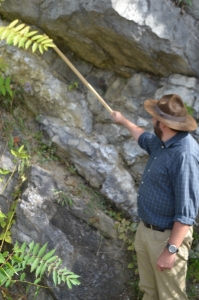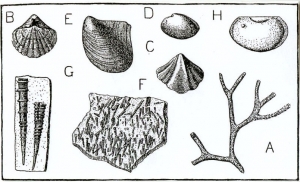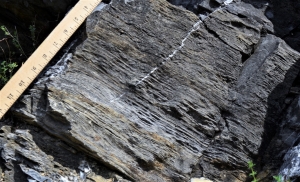The Devonian, Part two
The Greenville Press, Feb. 17, 2005
Updated by Robert and Johanna Titus
The last time we wrote, we traveled down Rte. 23 towards the Rip Van Winkle Bridge and looked at a unit of rock called the Rondout Formation. The strata of that rock unit took us back to a very old fossil mudflat at the edge of the Devonian age Helderberg Sea. This time let’s look at the overlying rocks. Those strata pick up right above the Rondout. The top of the Rondout showed some distorted strata. The next unit, the Manlius Limestone, lies immediately above them.

Geologist points at the Manlius Limestone
These strata are limestones. They are composed of calcium carbonate (CaCO3), and that makes them the same stuff that most of Florida and all of the Bahamas are made of. If you have been to either of those places, then you can begin to imagine what those limestones tell us about what this area was like back in the Devonian. It was tropical and covered by a sparkling, aqua-colored, very shallow sea. Actually, most of the Manlius was deposited within the tidal zone or just above the high tide mark.
In short, most of the Manlius was deposited in a broad tidal flat. It was not exactly a pleasant place to be. It was hot, salty and would have been really uncomfortable for humans. Not many organisms lived in this setting but there were some. There was a form of crustacean living there. This creature, called an ostracod (E in our second illustration), was a small and distant relative of the shrimp. Like brine shrimp these little fellows must have been tolerant of the very salty conditions that prevailed. Alongside the ostracods were some of those mysteries of paleontology, creatures we call tentaculitids (F&G). These were some sort of invertebrate shellfish but, exactly what, we can’t hope to ever know. They possessed handsome little conical shells and those cones were ornately ridged. There is nothing like them alive today and we, thus, have no way of ever figuring out what they might have been.

Ostracods and tentaculitids seem to have been pretty well adapted to life on the hot, mudflats, broiling in the tropical sun. Few other animals could, however, tolerate these conditions. But there was one form of life that did quite well in this setting. These were the blue green algae. They often go by another name, the cyanobacteria, and that name gives you a clue as to just how primitive and old these forms were. These ones are still alive, and we can study them, so we know a lot about them.
Cyanobacteria are, as the name implies, photosynthetic bacteria. That makes them very primitive one-celled organisms which were the earliest to photosynthesize. They first appear in the fossil record about three and one half billion (yes, with a b) years ago and that makes them among the oldest creatures that we know of. Hot, broiling, sunny days were common back then and these creatures, long ago, evolved a tolerance for such conditions. By the Devonian, they were old hands at life in such awful settings.
They formed algal mats that coated the old mudflat surfaces and we can recognize those mats in cross sectional views of the Manlius. We see thinly laminated horizons of the limestone. Each bed is an old algal mat. The algae grew and they were sticky so that grains of silt and clay would stick to them. That made the laminated rock that we see.

Not all of the Manlius was mudflat; the upper part of the unit was deposited in very shallow sea water, just deep enough for another whole ecology. If you look carefully in this outcrop, you can find the faint (very faint) images of reef building organisms. They are called stromatoporoids and these are very mysterious organisms. Just as with the tentaculitids, these forms have long been extinct. We can only guess what they amounted to in life, now they are just poorly preserved fossils. Please see last week’s blog.
The Manlius Limestone most likely records a long period of geological stability, but there are some interesting interruptions. There is at least one level we have evidence of serious erosion. Apparently, the crust buckled upwards (an earthquake?) and this was followed by a period of erosion as Nature sought to reestablish Her pre-uplift level.
Crustal activity such as this must have been very rare in the early Devonian, but as we shall see, this event was the harbinger of much more to come. To look at this erosional surface, and especially to touch it, is to be in direct contact with a moment in the past.
Aug. 23, 406,321,482 BC, high noon – The sky is clear and cloudless, and the Sun is positively baking the landscape below. It is extremely hot, well above 100 degrees, and to make it all the worse, the heat has pooled on the still surface. There is no breeze at all, and the light-colored landscape reflects wavy masses of hot air rising off its surface. This is the stuff mirages are made of, and in the distant east, there appears to be a large pool of water. There isn’t; Nature is trying to fool us.
But to the west there is water; it is the Helderberg Sea. It is active on this day; the large swells of approaching waves roll towards the coast. The waves consist of crests and troughs; it is the troughs that are most interesting. As they pass, they momentarily reveal the top of reef “heads.” These are the brief exposures of stromatoporoids. Too bad they are so far away; we might get a better look at them is maybe learn something about what they really are. But, in a flash, we lose interest in those stromatoporoids.
Suddenly, without any warning, comes a low rumble. It sounds like a very powerful loudspeaker playing a very low frequency sound. Then there is a shaking of the ground beneath us. The earth’s shaking picks up for a few seconds and the mudflat seems to roll and fold up and down just as the advancing waves had been doing, just seconds earlier. The ocean is churned up and wild with action. Now several large waves of displaced water crest and roll over what had been beach.
Almost as quickly as it began, the earthquake has ended. The mudflat is a mess, contorted, distorted and folded by the seismic activity. Strangely, the layers of sediment were cohesive enough to maintain much of their form in the thick of the activity. Now they look like shiny, light-colored carpets that have been folded. The mud flats are a good foot higher than before the quake; the crust has risen that much.
The water that has sloshed across the beach is flowing back into the Helderberg Sea. It is beginning to carve small channels as it finds its way downhill. It’s part of a process; Nature is already trying to lower what the earthquake has lifted.
Hundreds of millions of years from now people will come and look at all this.
Contact the authors at randjtitus@prodigy.net. Join their facebook page “The Catskill Geologist.”





